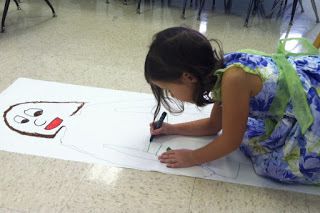Rebecca S. Ramsey's Blog, page 27
October 15, 2018
The Story of Samuel
 Welcome to the story of Samuel, the Godly Play story scheduled for this Sunday, October 21, based on 1 Samuel 1-28:3. You can find the script for the story in the pink Enrichment Presentations for Fall book, p.72-77.
Welcome to the story of Samuel, the Godly Play story scheduled for this Sunday, October 21, based on 1 Samuel 1-28:3. You can find the script for the story in the pink Enrichment Presentations for Fall book, p.72-77.
This week’s story is another one (like Ruth) that fits nicely after the story of the ark and the tent. And it follows right into the next story on our schedule: the story of David.
The story of Samuel is also very interesting to children because they relate to the idea of a child growing physically and in relationship with God and because they think about how God communicates- and probably wish that God would call their names in an audible voice.
Themes you might want to help the children think about:
1.God answers prayer
2. You can serve God even as a child.
3.God plans to take care of you. (If you want to use a memory verse, you could use Jeremiah 29:11)
4.God asks us to stand up for what is right, as Samuel did.
5.Obedience (Samuel obeyed God even though he was not happy that the people wanted a king.)
Ideas for the Make a Gift for God time: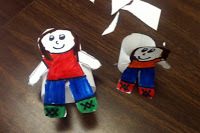 Remember that one of the most important parts of Godly Play is that it gives the child options in how she responds to the story. We want to give children as many chances to have say so in what they do as possible.
Remember that one of the most important parts of Godly Play is that it gives the child options in how she responds to the story. We want to give children as many chances to have say so in what they do as possible.
Of course one way to respond is to play with the story pieces, retelling it to oneself or to a friend.
2. Reproduce the story in some way- make pieces, such as the ark, a Baby Samuel, robes of different sizes, 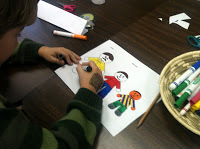 (showing how Samuel grew during his service in the temple), a sleeping mat, a crown
(showing how Samuel grew during his service in the temple), a sleeping mat, a crown
2. Children could make a life size drawing of themselves and caption it: I can serve God right now! This could be done by having another child trace around their body on butcher paper. They could draw clothes on their body or use fabric from the resource room. Maybe they could hold something in the drawing that gives a hint to how they can serve God right now.
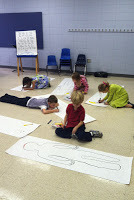
3. A collage or drawing of how children can serve God right now. Children could make these individually and then put them together as a class project. (Ways include how they treat others, through prayer, in worship at church, helping others…)
4. Children could think about how they might like to serve God in the future. How does a doctor or teacher or engineer or scientist serve God? They could explore this in a drawing or make a model with play clay.
5. Children could act out the story of Samuel hearing God’s call and going to Eli–and the rest of the story as well.
6. Hannah makes Samuel a new robe each year and brings it to him in the temple. Children could make a “robe” from a paper grocery bag as we often do with Joseph, as shown here. (Scroll down and see the child modeling hers!)
I can’t wait to see how the children think about this story!
For more art response ideas, see my Pinterest page, here.
October 8, 2018
The Story of Ruth
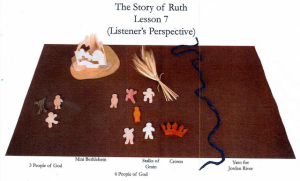 Welcome to the story of Ruth, the Godly Play story scheduled for this Sunday, October 14, based on the book of Ruth. You can find the script for the story in the pink Enrichment Presentations for Fall book, p.66-71.
Welcome to the story of Ruth, the Godly Play story scheduled for this Sunday, October 14, based on the book of Ruth. You can find the script for the story in the pink Enrichment Presentations for Fall book, p.66-71.
As the book describes, this story doesn’t “unroll” like many other stories, from left to right in chronological order. Instead it moves from the Promised Land (specifically Bethlehem) to Moab and back to Bethlehem. The whole felt block is shown throughout the story.
The story of Ruth follows the story of the Tabernacle, in which great emphasis was put on being one of the chosen people of God. It’s wonderful that we now can share the story of Ruth, not one of the chosen People of God, but a Moabite, yet she was clearly valued and loved by God. She married one of God’s People, Boaz, and eventually became the great grandmother of King David (and an ancestor of Jesus!) The story gives us a wonderful opportunity to remind children that God values “other-ness,” that all are included in and welcomed into God’s love and care.
Idea sparkers for the Give a Gift to God time:
There are several ways children and teachers can go with this.
1. Focus on the story itself.
a) Let the children act out the story.
b) Draw the scenes of the story or make a three dimensional representation of the story.
c) Help the children learn the meaning of “gleaning” by giving them a chance to do a modified form of it in this “gleaning game” (from the site here.)
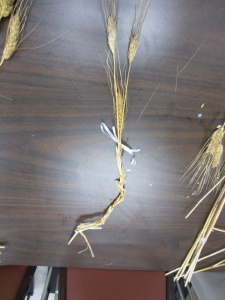 “Fill 2 roasting pans or cookie sheets with 2 lbs. of cornmeal and a cup of rice and place it in the center of the blanket. Set the paper cup to the side. Explain to the children that they will be gleaning grain just as Ruth did for Naomi. Divide the kids into two groups. Have each group stand around their pan. Ask them to work together to fill the cups with rice, one grain at a time. Tell the children not to put any of the rice into their mouths since it is uncooked. For a fun challenge, set a timer for three minutes. Ask the children to see if they can fill the “bushel” before the timer goes off. But remind them to be careful – if someone knocks over the cup they’ll have to start all over again.”
“Fill 2 roasting pans or cookie sheets with 2 lbs. of cornmeal and a cup of rice and place it in the center of the blanket. Set the paper cup to the side. Explain to the children that they will be gleaning grain just as Ruth did for Naomi. Divide the kids into two groups. Have each group stand around their pan. Ask them to work together to fill the cups with rice, one grain at a time. Tell the children not to put any of the rice into their mouths since it is uncooked. For a fun challenge, set a timer for three minutes. Ask the children to see if they can fill the “bushel” before the timer goes off. But remind them to be careful – if someone knocks over the cup they’ll have to start all over again.”
d) Let the children explore wheat. Give each child a single spear (I bought some from Hobby Lobby in the dried flower section) and let them try to separate the grains. Let me know by Tuesday if you’d like me to buy some wheat for your class.
e) Weave wheat into an ornament/hanging as described here.
2. Focus on friendship between Ruth and Naomi.
You can concentrate on the theme that friendship and the loyalty that goes with it is a gift from God. a) Children might make friendship bracelets, like those shown here. Or for younger children, make simple strings of beads made into bracelets. We have tons of material for these in the art storage room! Or make a necklace for a friend, as shown here.
b) Children could make a mural together of what it means to be a friend- what friends do for each other. Each child could work individually or in pairs- and put the works together as a mural or for a bulletin board in your classroom.
c) Make a Friendship wreath for your classroom, as shown here.
d) Examine the song, “Blessed Be the Tie That Binds” and let the children illustrate it.
3. Focus on God welcoming all people.
a) How are we welcoming to others who might be different? Children could make a collage for “God Loves Everyone”
b) Make a God’s Love Note for a friend- like the ones shown here.
For more ideas, see my Pinterest Page on the Ruth, here.
October 5, 2018
Anger, Out of the Closet
 Last Sunday morning, I stood in my closet and got mad at my clothes.
Last Sunday morning, I stood in my closet and got mad at my clothes.
It was going to be a busy morning and I had a ton of things to keep track of. In a few hours I’d be standing before our large congregation, handing out acolyte crosses to our new fourth grade worship leaders and giving out Bibles to our third graders. As our Children’s Minister, I had a litany to lead, a children’s sermon to give, 35 names to call out, a couple of prayers to pray, all while managing a microphone with a headset and carrying a clipboard with two sets of names, each one of which I needed to say perfectly. SO WHY DIDN’T ANY OF MY STUPID DRESSES HAVE POCKETS?
WHY?
I DON’T CARE IF POCKETS FLARE OUT AND LOOK MESSY.
I DON’T CARE IF THEY MIGHT MAKE MY HIPS LOOK BIG.
WHAT IS WRONG WITH YOU, DRESS DESIGNERS? WE DON’T LIVE IN DOWNTON ABBEY! WOMEN HAVE THINGS TO DO! WE NEED PLACES TO PUT OUR STUFF!
As I threw hangars around and kicked at my shoes, I caught a vision on myself in the mirror.
Maybe my clothes weren’t really the problem. Maybe I was angry about something else.
Yes. I believe I was.
I think I’ve been angry for a good while, though I’ve worked hard to keep it under the surface.
Thursday, it all spewed out. Literally.
I won’t go into detail for your sake, but let’s just say that when the most precious grandbaby ever came to visit Tuesday night, he gave his LaLa the World’s Worst Stomach Bug, which had hijacked my body by Thursday afternoon. Perfect timing, as I had listened to Dr. Christine Blasey Ford’s testimony before the Senate Judiciary Committee that morning as I worked. Then I’d had lunch with a bunch of women ministers and chaplains, where we talked about how Dr. Ford’s words had triggered those around us with their own memories of sexual harassment or abuse.
So yay. I drove home and spend the next 48 hours either flat on my back or throwing up into the toilet. Maybe it was the virus talking- or my sick stomach and exhausted, delirious mind- but as I vomited over and over, I thought to myself that at least it seemed right, given the news. I tried to chuckle to myself that it was like the time I took a broom to a Harry Potter film, or when my brother put on his football helmet to watch a game. I was throwing up in solidarity with the many friends I have who’ve been assaulted. I was throwing up for the times I’ve been harassed and wanted to scream but didn’t, the times I didn’t tell, because I didn’t see what good it would do.
And I was throwing up for Rachel.
I didn’t know Rachel (not her real name) before circumstances put us together. I noticed her bright eyes and her funny laugh and how very nice she was. A week into classes, I came home to find her being wheeled out of our dorm on a stretcher and taken to the hospital to have her stomach pumped. She had taken a bottle full of pills. Her boyfriend had raped her.
As I lay on my back on Thursday, trying to get the room to stop spinning, I remembered Rachel. I remembered the time we were sleeping in the same room and I woke up at 3 am with her face next to mine, ghostly white, her eyes wide, sleepwalking and crying that he was after her, that we had to move furniture in front of the door or he’d break in. I remember seeing him come around. I remember asking her why she wouldn’t file charges. I remember his sneer.
Maybe I was still mad about that.
I was also mad that people I know and love seemed to shrug their shoulders on facebook about Dr. Ford, or even worse. How could Christian people laugh? Had they not seen the research about how women rarely tell? Or the studies on the rarity of false reporting? That experts now say that the rate for false reporting is in the range of 2-8%? When a woman talks, the odds are pretty good that she’s telling the truth. We should at least listen. We should at least investigate well.
Maybe I was also mad because I am so tired of changing my own behavior to protect myself from being assaulted, from carrying a key in my fist at night to avoiding parking garages to looking in my backseat before I get into a car. And even though I want the future to be unlimited for my daughter, I had to teach her these things as well, as everyone does. If Sarah had come to me begging to go to college in downtown Chicago, would I have said, “Go for it!” as I did for Sam? I don’t think I would have, and I’m mad about that.
So I was mad, and a little light headed, as I put on MY ONE DRESS WITH POCKETS that I had just worn the week before, and headed off to church.
It was a good place to go, THANK GOD. (Really, thanks, God.)
Don’t get the wrong idea…I’M STILL MAD. I’ve still had it with this awful broken world, full of abuse and hurt and idiocy, when we lean into our own understandings, when we arm ourselves with our fears and bully each other. I’ve still had it with sexism and racism and ugliness. But God showed me some goodness that’s soothing my heart and at the same time, firing me up. Feeding me. Resting me. Igniting me.
God showed me 19 fourth grade girls and boys who said yes to serving as acolytes, to show up with a partner, put on robes and crosses, and walk down the aisle in front of everybody, signaling the whole crowd that God is in the house. They march in first, because A CHILD WILL LEAD US and they come bearing FIRE and a big heavy Bible so that we can get it through our think heads that this is not a PTA meeting. We’re meeting up with the HOLY, so take off your shoes! And then when worship is done, they march it all out again in front of us, so that we remember that as we get in our cars and go out to lunch- or head home where we’ll eat leftovers and argue about not getting on the computer until the homework is done, Jesus goes with us. He doesn’t relax on the pew with a coffee and turn on the game. He climbs in beside us and rides into that awful broken world with us, whispering to us the message from the sermon that day, that LOVE DRIVES OUT FEAR. And if we’re not careful, FEAR DRIVES OUT LOVE.
God also showed me Riley.
At the beginning of our children’s sermon, I noticed aloud to the kids that we had a nice big group gathered there on the platform, but there was a whole class of children missing. “Look at them smiling,” I said, nodding at the third graders still sitting in the center pew. “It’s because something special is about to happen to them.” And it was. Each of them was about to receive a gift from the church, her own Bible, inscribed with her name. “Do you know what is special about today?” Did they know what made today different?
Riley’s hand shot up. His whole little first grade face lit up. “IT’S SUNDAY!!!!”
Yes! Maybe Sunday is an amazing, radical thing!
It’s SUNDAY and we get to leave our homes and dirty dishes and the dog poop that is still in the back yard because somebody didn’t clean it up like they were supposed to and we drive to a building where we can close our eyes to the darkness of the world and ask God to descend upon us and hold us and revive us and point our eyes to what the world needs. We devote a couple hours to God who loves us no matter who we are or what we’ve done.
But maybe this is not what Riley meant. Maybe Riley meant that Sunday is special because he gets to hang out where people love him and his family, where he gets to eat doughnuts and play ping pong and then hear a story about God who loves him too and will never leave him no matter what. And then he gets to go to worship in a big room that gets filled up with God, with a loud organ with music you can feel in your bones, and a special meal where we basically eat Jesus because we love him so much and want to take his words and love into our bodies right down to our toes. And then, when it’s done, we get to have a Jolly Rancher dessert from Miss Becky’s office, because you can’t have too much joy. That’s good too.
And then God showed me the third graders, and the way they held their new Bibles like it was the Ark of the Covenant, and they were the priests who could touch it if they were really careful. REALLY CAREFUL, because this is God’s word.
From my seat on the platform I watched one of our girls finger her name on the cover. Yes, child, it’s meant for you, this book of sacred stories of normal, broken people, each bad and good, who broke all God’s rules and did some real dumb, dangerous, hurtful things to each other because God couldn’t have all the power. And still God loved them, pursued them, never gave up on them, even to the point of putting on human skin and coming down here on earth to show us how to live. God loved them to the point that they killed him. But even that wouldn’t stop a love like that. Nothing can separate us from the BIG LOVE of God.
Yes, children. You are worth that kind of love.
You are worth God’s love no matter what you’ve done or what others have done to you.
You are worth loving yourself and taking care of yourself.
You are worth justice and kindness and mercy.
You are worth being who God made you to be.
You are also worth anger. Sometimes it’s the only way to holy change.
Thank you for showing me the way.
Oh, and one more thing: you are also worth pockets.
I’m just saying.
October 1, 2018
The Ark and the Tent
 Welcome to the Ark and the Tent, the Godly Play story scheduled for this Sunday, October 7, based on Exodus 25-31, 35-40. You can find the script on p.81-86 in the orange book (The Complete Guide to Godly Play, Vol 2, 14 Presentations for Fall, by Jerome W. Berryman).
Welcome to the Ark and the Tent, the Godly Play story scheduled for this Sunday, October 7, based on Exodus 25-31, 35-40. You can find the script on p.81-86 in the orange book (The Complete Guide to Godly Play, Vol 2, 14 Presentations for Fall, by Jerome W. Berryman).
Children always get so excited about this story. They love the little pieces belonging to the tent, I think partly because each piece comes with a tradition. We all know how kids LOVE traditions–knowing the proper way to do things and the reasons behind why we do them. Bringing a sacrifice for the altar, washing at the laver before entering the tent, burning incense, placing 12 pieces of bread on the table, lighting the menorah…it all has meaning, centered upon being ready to meet God.
There are different approaches to this lesson that teachers can take. Of course we can all go through a study of each of the steps of getting ready and the tools mentioned above to help them get ready. Many churches still use several of these today. Are there any that we use? Are there new ones not included with the tent?
We can also think about how we get ready to do different things in our lives–to go places that are important to us, for example. How do we get ready to hear our Godly Play stories? Why is that important? How do we get ready to be with God? What do we do? How exactly do the routines we do help us get ready? Can we practice getting ready to be with God when we’re at home too? How would we do that?
One thing that the Godly Play script doesn’t highlight which you may want to include is the idea that all the people of God were invited to give something of their own to creating the tent of meeting–not just jewelry or fabric or wood, but their own craftsmanship. It was created by the people of God, for God.
Ideas for Art Response Time
This story is practically BURSTING with ideas for little hands–and big ones too!
I can easily see the activity time for this story beginning this Sunday, but continuing at least one other Sunday. Soon we’ll do the Ark and the Temple, so the work could easily continue with that story too.
Here are some that I came up with to add to your own. (And please, do feel free to write a comment to share your own ideas!)
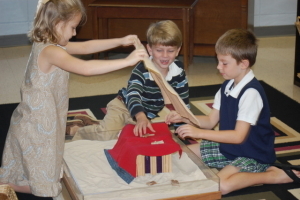


Children might like to make their own collection of getting ready pieces like a menorah, an incense holder, a laver, an ark. They could make tiny pieces with clay or boxes or pieces of wood or whatever materials we have.
Or they could spend more time on making individual pieces. The menorahs above are made from a big clay “worm” in which popsickle sticks (which have been colored with crayons) are inserted. Sequins and beads have also been pressed into the clay.
Here are some websites with more great ideas and directions:
How to make a potato menorah:
www.jewishappleseed.org/apple/potatomenorah.htm
How to make a menorah from clay:
www.familyfun.go.com/crafts/clay-menorah-666608/

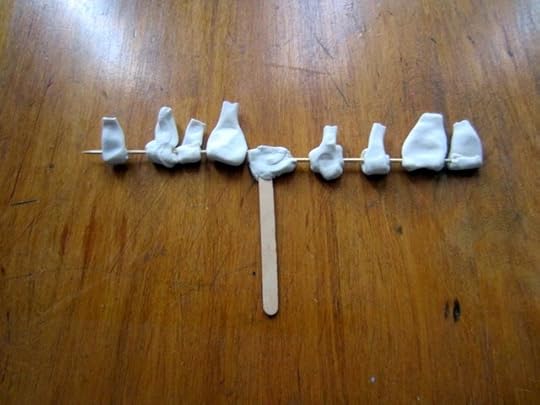
Of course our children will come up with more creative ideas than we can!


Some things to ask them:
How could we make a laver?
What do we have in our classroom which might make a good altar?
A table for the 12 slices of bread?
An ark of the covenant? How about decorating a box with gold wrapping paper for the ark?

What about the poles that carry it?
(Wouldn’t it be fun to light some incense and see what it smells like?)

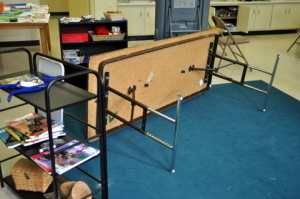
If we’re going to make all those pieces, why not make a tent of meeting in which to put them?
A table turned on its side could give us the framework.
There are a few tablecloths folded up in the art supply room to serve as the tent fabric.

What if we brought blankets from home? We could even have a four layer tent, much like the tent is described in the Bible.
Once the tent is made, we could put all the pieces we created inside it. How would we separate the Holy of Holies?


Or we could make a small tabernacle out of cardboard and fabric.
There’s so much to think about. I can’t wait to see what your classes create! If you take photos, please share them with me. I’d love to add them to the parent newsletter!
Have fun, y’all! And for more ideas, including snack ideas for the lesson, see my Pinterest page on the story, here.
September 24, 2018
The Ten Best Ways to Live
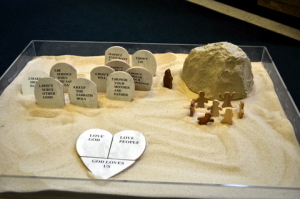 Welcome to The Ten Best Ways, our Godly Play story for this coming Sunday, Sept. 30. You can find the story in Exodus 20:1-17, Deuteronomy 5:1-21. The Godly Play script can be found in the 14 Presentations for Fall book (the orange one), p. 73-80.
Welcome to The Ten Best Ways, our Godly Play story for this coming Sunday, Sept. 30. You can find the story in Exodus 20:1-17, Deuteronomy 5:1-21. The Godly Play script can be found in the 14 Presentations for Fall book (the orange one), p. 73-80.
I love that Godly Play refers to the Ten Commandments as The Ten Best Ways and places them in a heart shaped box. This helps us remember that our God is not a supreme dictator who exists just for the chance to squash us when we don’t adhere to his rules, but is instead a God who loves us enough to want to give us boundaries, so that we can fully enjoy the life God meant for us.
In preparation for teaching the lesson, it’s good to look back at the session that precedes it: the Exodus. God has led his people out of slavery, away from Pharaoh and the soldiers chasing after them, through the sea, into freedom. Now they can live where they want, do what they want, be who they want. As the story script says, “Now that the people are free…where will they go now? What is the best way?”
Thank goodness (and thank God!) that God provided divine guidance, motivated completely by love.
What to focus on? Here are some general ideas :
1. The younger classes (first grade and younger) might choose to keep things simple by focusing on the first heart in the box: Love God, Love People, God Loves You. Or, depending on the children, you could go deeper and study all the commandments. You probably have an idea of what the children can handle best.
2. Study each of the commandments by reproducing them in some way.
3. Explore the idea of Moses being the only one with the courage to climb up into the fire and smoke to meet God. Children will find it interesting that God wanted to protect Moses from his powerful presence, so God put him in a crevice in the rock and put his hand over him until he had passed by, allowing Moses to see his back. I love the line, “When we see God’s back, we can follow God all of our days.”
4. The older children may benefit by exploring the conflict that comes when we find ourselves stuck between two commandments, like when Grandma gives you a present that you don’t like and asks you what you think of it. How do we love others and still stay true to the truth?
We should also address more close to the heart conflicts, like divorce. Many of our children are experiencing divorce and will be listening especially to the Best Way of honoring marriage. We need to be sure to include in our session a focus on grace and forgiveness. Sometimes people try their very best to honor the Ten Best ways, and it just doesn’t work out. God always offers love and forgiveness to all. His love never stops, no matter what.
Art Response Ideas:
* Give the children big construction paper hearts divided into the sections Love God, Love People, and God Loves You. “I wonder how you could illustrate each section?” Children could choose whether to draw or cut pictures from a magazine or paint with watercolors. Or children could work together on one huge heart of butcher paper, contributing illustrations for each section. (This idea is especially for the younger children.)
 *Let each child make a set of commandments, painting the tablets with watercolors after they write their version of the Ten Best Ways. It’s beautiful…see here.
*Let each child make a set of commandments, painting the tablets with watercolors after they write their version of the Ten Best Ways. It’s beautiful…see here.
*See this version done on slate.
* I wonder if we could make a Mount Sinai? (With a cleft for Moses to hide in!) Could we make Moses out of a clothespin? How would we make the Ten Best Ways?” The youngest children might need ideas from which to choose.
 *Could we make a huge set of Ten Best Ways together for our classroom? As tall as a child? Could we illustrate each commandment? Which one would you like to work on?
*Could we make a huge set of Ten Best Ways together for our classroom? As tall as a child? Could we illustrate each commandment? Which one would you like to work on?
 *I wonder what materials we might use to make individual sets of Best Way hearts, so that you can take it home with you. (You might want to see what kind of interesting materials you can find at a craft store. Save your receipts and I’ll reimburse you.)
*I wonder what materials we might use to make individual sets of Best Way hearts, so that you can take it home with you. (You might want to see what kind of interesting materials you can find at a craft store. Save your receipts and I’ll reimburse you.)
*I wonder if you can make up hand motions to illustrate each individual Best Way? Could you split them up among children and videotape each one, making a video the whole class can enjoy? (If somebody does this I’d love to share it with parents!)
 *I wonder which is your favorite commandment? Would you like to concentrate just on that one, making a 2 dimensional or 3 dimensional representation of it? (a drawing or collage or making a scene out of play clay, etc?)
*I wonder which is your favorite commandment? Would you like to concentrate just on that one, making a 2 dimensional or 3 dimensional representation of it? (a drawing or collage or making a scene out of play clay, etc?)
Obviously, we wouldn’t want to present ALL of these options to the class, as that might be too overwhelming. But it’s a list I hope will help you…and get you started thinking of your own ideas.
And if you’d like more ideas, check out my Pinterest page on the Ten Best Ways, here.
Enjoy!
September 18, 2018
Are You Avoiding Something? Five Tips for Doing the Hard Thing from a Team of Experts I Know
 Kids can be masters at avoiding things.
Kids can be masters at avoiding things.
If you have children, this will not be a surprise to you.
Unless you have a rare bird child, whose keeps his plumage preened perfectly, who puts on her bird pants before breakfast without spending fifteen minutes making trick shots of her bird pajamas into the hamper, who shows up at the birdseed trough right on time without dawdling in front of the television, who does all the bird chores before you shake your tail feathers at him even once, you’ll agree. Children are real crackerjacks at avoidance. They figure out all the sneaky ways to avoid cleaning their rooms, avoid doing their homework, avoid taking a shower at church camp (I’m looking at you, child who knows who she is!)
So it might surprise you that after church on Sunday, I discovered that these baby faced procrastinators have a hidden superpower! Believe it or not, children actually know all the secrets to doing the hard things! In fact, they’ve written the manual on the subject in their uniquely profound / hilarious / no nonsense way!
I know because I caught them. Or I should say that their Sunday school teachers did.
We shared the story of Moses on Sunday– the first part, how his mama sent him down the river in a basket rather than hand him over to certain death, how he was raised by the pharaoh’s daughter, how he killed an Egyptian he saw beating a slave, how he ran away and hid, lived life as a shepherd, and finally, how God spoke to him through a burning bush, volun-telling him to be the one to go demand freedom for the Israelites from Pharaoh.
Quite a story. And we hadn’t even gotten to the most exciting part yet.
After the story was done, the teachers asked them questions to help them process the story. Their responses to the last question revealed the children’s secret: I wonder what Moses did to get ready to speak to the Pharaoh about setting the people free.
The kids had ideas.
Y’ALL. Their responses read like a tip sheet: How To Do Hard Things!
Don’t worry. I’ll share.
“Take a deep breath in and a deep breath out.” (Contributed by a first grader.)
Yes, wise first grader! When you need to do a hard thing, the first thing to do is to get calm. Look around and take in the situation.
Breathe. Listen to your own thoughts. God might speak through them.
Listen to all the voices for what they’re actually saying, apart from emotion. God might speak through them.
Then just listen to your own breath. In. Out. God might speak through it too.
“Pray” (Contributed by a first grader.)
Great Sunday school answer, first grader. And so true! God knows your thoughts, but let God hear you say them. Say your feelings and your worries and your questions and inner turmoil.
Then listen. Still your mind. Feel the quiet.
Meditate on your question to God like sucking on a cough drop. Let it dissolve. See what comes.
Listen some more. Don’t rush.
“He got his brother. He got help.” (Contributed by a second grader.)
Second grader, you’re smart! We don’t have to pretend we have it all together. Why do this by yourself? Find someone who has been in this hole before, or has skills that you don’t have, and ask if you can lock arms with her. Share your trouble and then listen.
Find a whole support team if you need it. We belong to each other, right? So give someone the gift of helping you.
“Think about it, PRACTICE and pray.” (Contributed by a third grader.)
Look at you, third grader! So wise! Practice usually makes perfect- or maybe good enough! Practice the hard words you need to say. Act it all out. Try different approaches. And as you do, listen to yourself. Listen to feedback from others. Listen for feedback from God.
“Dress like a wise stranger.” (Contributed by a fourth grader.)
Fourth grader, I wonder what exactly were you thinking? BUT HOW I LOVE this answer! I googled this, AND LOOK WHAT CAME UP!
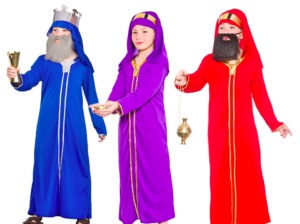

I doubt this child was advising us to put on a wiseman costume or dress like one of the kids from Stranger Things. Maybe he/she meant that after you’ve prayed and practiced and thought and LISTENED, go for it! And if you’re going to go for it, DRESS THE PART, from the inside out! Believe you’re equipped to do the hard thing! Put on your super suit and get it done.
“Think, practice, pray and HAVE FUN!” (Contributed by a fifth grader.)
Find the funny. It’s great advice, no matter what you’re doing. (Unless I’m trying to get you to clean your room or get homework done or take a shower!)
May we all have a wise team of experts to call on!
September 17, 2018
The Exodus
 Welcome to our lesson for Sept 23, The Exodus, found in Exodus 11:1-15:21. The Godly Play script is in the yellow (Fall) book, p. 65-72.
Welcome to our lesson for Sept 23, The Exodus, found in Exodus 11:1-15:21. The Godly Play script is in the yellow (Fall) book, p. 65-72.
When we left Moses last week, he was getting ready to go with Aaron to speak to the Pharaoh and to do what God told him to do: set the people free. Would he have the courage? Would God help him? How would it all play out? This week we get to celebrate the answers to these questions.
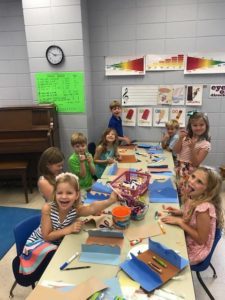
I would suggest telling the story as the script describes, and then, when Moses enters the scene, recap last week’s story before moving on, so that children can connect the two stories.
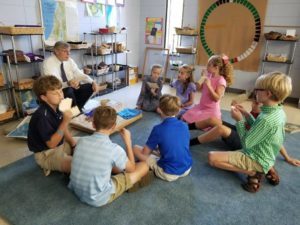 If you’re up for it, you might want to consider celebrating the story with an exploration of the seder meal, as described below. If you’re not up for that, I’ll have matzo for each classroom for the children to try.
If you’re up for it, you might want to consider celebrating the story with an exploration of the seder meal, as described below. If you’re not up for that, I’ll have matzo for each classroom for the children to try.
I’ve changed the wondering questions a little bit:
1. I wonder what part of the story you like the best.
2. I wonder what part is the most important.
3. I wonder if you were one of God’s people, how you might have felt when the Pharaoh set you free to follow Moses.
4. I wonder what you might have felt as you saw the sea part and a path emerge.
5. I wonder what part of this part of this story is about you, or what God is teaching you about Himself in this story.
Create a Gift for God Time
1. Children could recreate the story scene of the crossing of the Red Sea. Let children decide how they want to recreate this. They could make the pieces of the story- like the chain, the felt water that can be parted, the people, etc.
There’s an amazing example here. Take a look!
Here’s another example.
I’ll have blue paper and felt.

2. Children could work together to create a long chain, symbolizing the slavery the people of God had to be freed from. Here’s a pic of last years chain from 2nd grade.

Flickr photo of the seder courtesy of Imaginary Girl, through creative commons
 3.This would be a perfect time for the children to celebrate the seder meal. We did this in VBS a few summers ago and the children might remember enough to teach you about it! Just bring me a clean receipt and I’ll be glad to reimburse you. The meal is so full of meaning, all centered around this story.
3.This would be a perfect time for the children to celebrate the seder meal. We did this in VBS a few summers ago and the children might remember enough to teach you about it! Just bring me a clean receipt and I’ll be glad to reimburse you. The meal is so full of meaning, all centered around this story.
Here’s a guide with a simple explanation.
This allows our children to experience the Passover in a small way.
4. Children could make an instrument like Miriam might have used to celebrate the exodus. Lookhere for an example of a paper plate shaker. Let the children decorate it as they wish. We have paper plates and may have jingle bells, as well, in the art resource room if you want to use them.
For more art ideas, check out my Pinterest page, here.
Thanks y’all, for helping our children not only hear the story of the Exodus, but participate in it as well!
Love, Becky
September 9, 2018
The Story of Moses: The Beginning
 Welcome to our lesson for September 16, The Story of Moses, found in Exodus 1:8-17:7, 19:1- 40:38. The script is adapted from the story found in the pink Enrichment Presentations for Fall book, p.58-65. Sunday school teachers, I will emailed you a copy of the adapted script. If you’d like a copy and you’re not at FBG, feel free to email me and I’ll try my best to send it out to you.
Welcome to our lesson for September 16, The Story of Moses, found in Exodus 1:8-17:7, 19:1- 40:38. The script is adapted from the story found in the pink Enrichment Presentations for Fall book, p.58-65. Sunday school teachers, I will emailed you a copy of the adapted script. If you’d like a copy and you’re not at FBG, feel free to email me and I’ll try my best to send it out to you.
What an exciting story- and one children always love. Perhaps as we think about Moses’ humble beginning, our children will reflect on their own beginnings and know that they can be used by God to do great things for God’s kingdom as well. Most all of us can identify with not feeling up to the task or equipped to serve God. Moses’ story shows that willingness is all that it takes, that God will take care of the rest.
The timing of this story works well too with our story schedule, since we just shared the lesson of Joseph and will cover the Exodus story next. This adapted script ends right before Moses goes to talk with the Pharaoh, so the Exodus story can be shared as written in its Godly Play script. Be sure to end this story helping the children enjoy the suspense for next week’s lesson. It would be wonderful for them to go home asking what happens next, and reflecting on the story of the day.
Here are the wondering questions:
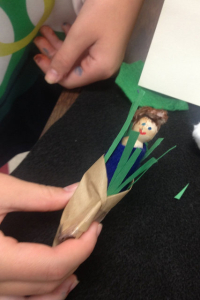 1. I wonder what was your favorite part of today’s story?
1. I wonder what was your favorite part of today’s story?2. I wonder what was the most important part?
3. I wonder if Moses ever made bad choices. I wonder if God can use people who sometimes make mistakes.
4. I wonder how Moses felt when God told him that God wanted Moses to set the people free from slavery.
5. I wonder what Moses did to get ready to speak to the Pharaoh about setting the people free.
What fun the children will have in our Make A Gift for God Time!
Here are some ideas to get the children started in planning their work:
1. Children can recreate the Moses in the Reeds scene, as shown here. (Scroll down to the part showing Moses in an Egg Carton Cup) Children can make their own basket and baby Moses using an a cup cut from an egg carton or paper bag- and whatever they like to make Moses (paper or a cotton ball for a head, felt for a blanket, etc). Blue construction paper could be the river and green for the reeds. They could even make the rest of the materials in the Godly Play story basket: a paper chain, a shepherd’s crook, the burning bush.
So that they get more invested in their work, allow them to make as many choices as to how they create the scene as possible.
I’ll have egg cartons, cotton balls, felt, and construction paper on hand on the cart at the end of the hall. Be sure to take photos of their work! [image error]
September 4, 2018
The Story of Joseph
 Welcome to the Story of Joseph, found in Genesis 37:1-31 and 49:1-6. (The script is found in the pink Enrichment Presentations for Fall book, p.51-57.)
Welcome to the Story of Joseph, found in Genesis 37:1-31 and 49:1-6. (The script is found in the pink Enrichment Presentations for Fall book, p.51-57.)
Since we just presented the Story of Jacob last week, this is the perfect time to talk about Jacob’s son Joseph. This story will help the children answer the question of how the people of God moved to Egypt and became slaves–which will help the Moses story and the Exodus story make more sense.
I’m sure that the children will find many parts of the story interesting- like the idea of Joseph being the favorite son, the sibling rivalry between the brothers, the enslavement and imprisonment of Joseph, the idea that dreams mean something, and the repairing of the relationship between Joseph and his brothers.
Ideas for our Make A Gift for God Time:
 Children could recreate the story in some way. Please remember that the activity will mean more to the children the more choices they have in how they decide what “work” to do and how they will accomplish it.
Children could recreate the story in some way. Please remember that the activity will mean more to the children the more choices they have in how they decide what “work” to do and how they will accomplish it.
1. Children could make a coat of many colors.
There are lots of ways they could do this. Several are described here. If the children want to make a coat of construction paper and trimmings, I’ll have construction paper, rickrack, buttons, etc on our cart at the end of the hall.
2. You could let the children pick scenes from Joseph’s life to draw out and put them together to make a mural of the different scenes. You could include in these the dreams he interpreted. We have plenty of huge mural paper.
3. Kids could make Egyptian costume pieces and act out parts of the story. Costume pieces are shown here. We have all sorts of fabric, beads, card stock, etc for the costumes. I’ll pull some to have on the cart on the hall.
4. You could also help the children explore what God is teaching us through Joseph’s story–how he mends his relationship with his brothers, despite everything, how he remains faithful to God in the middle of his troubles, and how God uses Joseph throughout his life. Could the children sketch and then paint with water colors ( or use marker or crayon) the scene of Joseph reuniting with his brothers? Maybe this could be a class project. Watercolors will be on my cart.
5. Don’t forget that one choice for a child’s work can always be to retell the story (using the materials that the teacher used) to another child. They love to handle the materials themselves and can use the laminated card to check themselves, to make sure they include all the parts of the story.
For more ideas on directions children can take with art response, see my Pinterest page here.
Enjoy
August 31, 2018
The Anonymous Letter Someone Left in My Mailbox and What I Intend to Do about It
 A mystery neighbor left us a letter in our mailbox today.
A mystery neighbor left us a letter in our mailbox today.
When I first opened the box and saw it there, a piece of notebook paper scribbled in pen, folded on top of our mail, I thought, Uh oh.
A couple of months after we first moved in, one of our neighbors (who has since moved away) ambled over, stood in our yard, put his hands on his hips and sighed. He surveyed the lines of weeds rising out of our mulch beds like little green soldiers and said, “The guy before you kept everything so sharp and neat. I used to love looking at your yard as I walked by.”
“That must have been nice,” I said and grinned at him, hoping a smile might help. Then I shrugged my shoulders. “Maybe we have other gifts,” I laughed. He grumble-chuckled and moved along.
So five years later, had my neighbors had enough? Had they been meeting together in secret in the bamboo grove at the bottom of the hill, planning their yard intervention?
What exactly was the problem? Was it the garden hose sprawled out all over our front yard? I’d tried to get Sam to roll that up after he washed his car, but he’s been busy getting ready to go back to school, and it’s been so hot that I’ve felt no guilt walking right past it on the way to the air conditioning. Was it Rosie’s barking, defending her territory from the dozens of people who walk or jog down our street everyday or the occasional cardboard box left by my neighbor’s trashcan that just might storm across the street and attack her family? Or was it that we never hung ferns from the fern hanger post in our front yard, which, according to our frustrated neighbor, was always adorned with the fern-iest ferns of the fern world before we came along?
I’m afraid that whatever the problem, it was largely my fault. I have not done a lot to befriend my neighbors. I LOVE people, I really do. They’re all God’s children and I LOVE THEM SO MUCH. But being an introvert, when it comes to my neighborhood, my very own Hobbit Hole, I love God’s kids best from twenty feet away, as we wave to each other and shout hello’s and how are you’s from across the street.
There are exceptions to this rule, I will say. I still miss my dear friend Bette, our next door neighbor from our old house in Greer. I miss her and Dale and their girls and grandkids and their dog Sparky and all the laughs and tears we shared as my kids were growing up. And if you’ve read French By Heart or The Holy Eclair, you know how much I loved cantankerous Madame Mallet, in spite of herself, even though SHE DROVE ME CRAZY with all her spying on us through her lace curtains and advice giving and her take charge attitude about my cherry tree and my barefooted sauvage children.
When it comes down to it, my husband, however, is the friendly guy who plants eight times more muscadine grapes than we need by the road so that the whole neighborhood can help themselves. He’s the one who stops walkers in the street and becomes their best friends, while I watch from the kitchen window, shaking my fist at them as they let their dogs pee in our yard WITHOUT THE SLIGHTEST BIT OF SHAME! (Okay, I admit that I let Rosie pee in the grass on my walks, but not in anybody’s front yard!) Don’t these people know that dog pee kills the weeds which cover our dirt and kind of look like green grass from a distance?!
 So I took the folded hate mail and the rest of it into the house, poured myself a cup of coffee for courage, and unfolded the letter.
So I took the folded hate mail and the rest of it into the house, poured myself a cup of coffee for courage, and unfolded the letter.
Oh y’all.
It’s not hate mail!
It’s a love letter!
Somebody loves our grapes!
When Todd planted the grapes, I admit, I wasn’t particularly encouraging. Not everybody enjoys muscadines. Pop one in your mouth, bite through the tough hull, and out squirts a grape eyeball onto your tongue. I’ve grown to love the sweet peppery-ness of the juice, but it’s an acquired taste. I wondered aloud if our neighbors would be interested in grapes that require so much spitting, both the hulls and the seeds. But Todd is used to my ways and happily ignored me and planted them anyway. And when they started getting ripe, my middle man-child who lives with us
I wondered aloud if our neighbors would be interested in grapes that require so much spitting, both the hulls and the seeds. But Todd is used to my ways and happily ignored me and planted them anyway. And when they started getting ripe, my middle man-child who lives with us liked the idea of sharing the grapes so much that he even made a sign (despite his own introversion.)
liked the idea of sharing the grapes so much that he even made a sign (despite his own introversion.)
See?
So maybe it’s time for me to turn over a new grape leaf.
Maybe it’s time that I join with the guys in my family in embracing the idea of inviting people into my yard. We’re so divided in this country these days. Maybe muscadines in all their peppery sweet eyeball-ness can bring us together, at least on my street, for the next few weeks. We can eat and spit in unison for as long as the grapes last.
While we’re at it, maybe I could even become the Miss Bette or the Madame Mallet (minus the lace curtain) for the families around us. I think I have the energy to do that, as long as my house/ Hobbit Hole/Palace of Introversion is there for me to retreat to when my energy runs out.
It’ll be fun! Barefoot kids are just my style!
(Just send the doggies down to pee in the bamboo grove down the hill, pretty please!)

